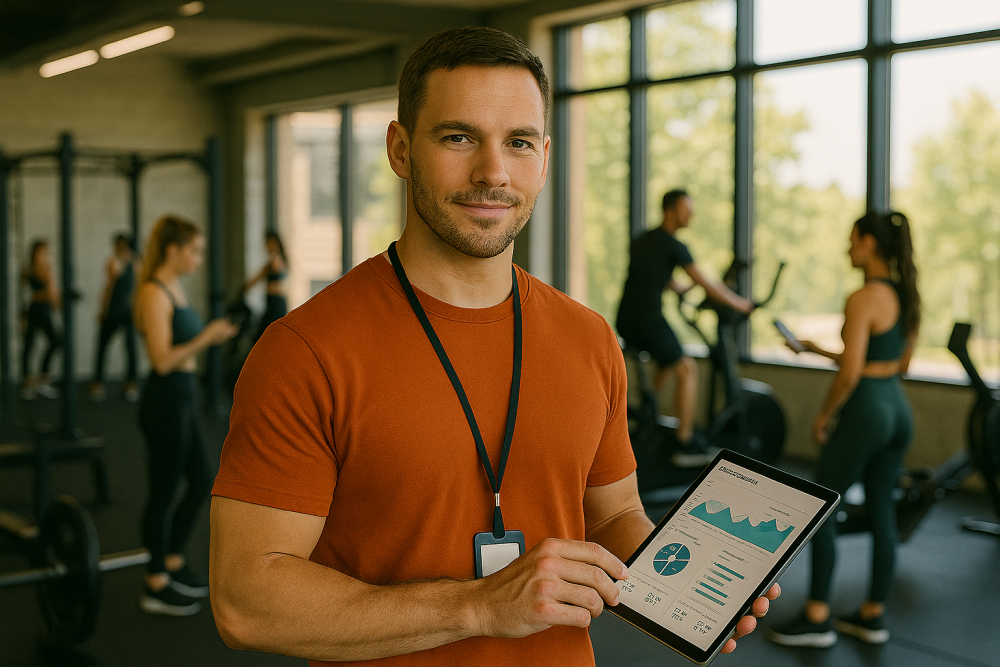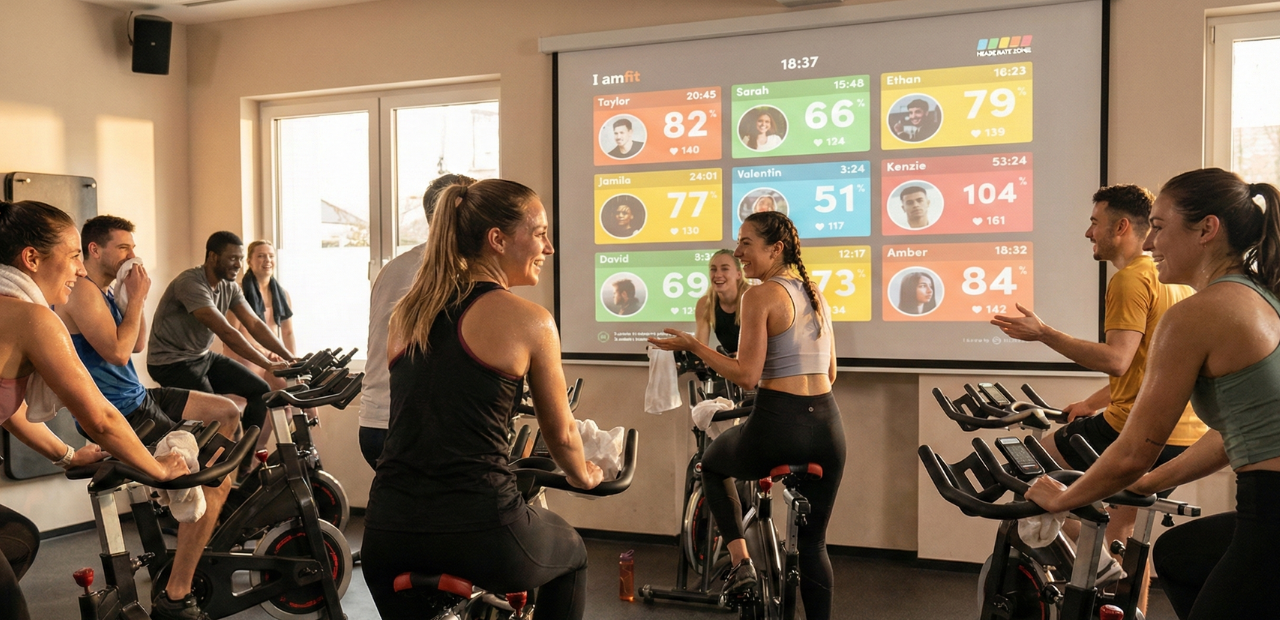Let’s face it: running a fitness business is hard. Between staff management, member engagement, billing issues, scheduling headaches, administrative tasks, and the occasional burst pipe in the locker room, gym owners wear a lot of hats—and not all of them fit comfortably.
It’s no wonder that more fitness businesses are turning to gym management software. But here’s the catch: not all software is created equal, and not all owners are sure where to begin.
In this post, we’re going to break down what gym management software can actually do for your operations, how real gyms have made it work, and what specific features are worth paying attention to.
No fluff. No jargon. Just real talk from real people in the industry.
How a software optimizes your gym operations?

We’ll start with the big picture: why bother with gym management software in the first place?
Because it saves time. And that saved time? That’s fuel for growth.
For example, Virtuagym reports that gyms fully using its system saw:
- 42% more memberships over 24 months
- 77% revenue growth
These numbers aren’t theoretical. They’re real-world results tied to efficiency gains, improved member experiences, and smarter business decisions.
But here’s the key: simply having software isn’t enough. To truly optimize your gym operations, you need to know how to apply its features strategically — from streamlining scheduling to automating billing, improving member engagement, and using data to guide decisions. The right software becomes not just a tool, but a blueprint for operational excellence.
What a gym management software actually does
When gym owners talk about “gym management software” they’re really referring to a toolkit that handles all the invisible gears that keep their gym business running.
A proper gym management system doesn’t just digitize your calendar—it reshapes the entire operational structure of your club.
Here’s what a solid gym management platform typically covers:
1. Class scheduling & calendar management

Let’s talk calendars. If you’re still using spreadsheets to manage staff and class schedules, you already know the pain: last-minute cancellations, overbooked sessions, and double-booked trainers.
Modern gym software gives you a centralized dashboard to schedule group classes, personal training sessions, and workshops.
Absolutely Fitness, a UK-based gym chain, tackled this with scheduling tools inside Virtuagym. It allowed members to book sessions online while giving staff real-time visibility. Fewer errors, happier clients, less back-and-forth.
“We’d been looking for a solution to that challenge for a while,” said Jack Bishop, Commercial Manager. “Scheduling used to be a nightmare. Now it’s something we don’t have to think twice about.”
Members can book directly through an app, see real-time availability, and even join waitlists. This eliminates double-bookings, last-minute confusion, and staff headaches.
2. Membership management

This feature is a lifesaver for gym owners juggling multiple membership tiers.
You can automate renewals, pause memberships, send reminders for expiring contracts, and track attendance trends.
Every gym deals with admin overload. Contract renewals, late payments, cancellations—they take time and mental energy. For example, Grupo Magma Muscle Factory in Spain streamlined all this with digital membership tools. Noelia Ferreiro, co-founder, said the billing features alone were a lifesaver.
“Billing with Virtuagym Pay has been a total game-changer for us,” she said. “Without it, managing payments would be a daily stressor.” Automated renewals and alerts for expired cards helped them avoid awkward conversations and cut down on missed revenue.

A gym management system can even group members based on behavior or goals, giving you personalized insights to enhance the member experience.
Another example is Workout Anytime, a U.S.-based chain with 170 clubs, took things a step further with PRO+ digital memberships. This helped them reach people who weren’t quite ready to return in person.
They provided video workouts, health tracking, and a robust mobile app that integrated seamlessly with wearable tech.
The payoff? An average of 1,000 new members per week.
3. Automated billing and payment processing

One of the most time consuming tasks in a gym is collecting payments.
Did you know that 3% to 10% of gym transactions typically fail due to payment issues? This creates hidden costs in gym operations and disrupts financial planning, adding up to hours of manual follow-up each month.
With built-in tools, you can automate monthly fees, manage one-off purchases, offer flexible payment plans, and follow up on failed transactions. This improves cash flow, reduces the mental load, and cuts down on awkward payment chases.
By automating billing reminders and retries across various payment methods, gyms like Magma Muscle Factory have reclaimed that time and improved their financial performance.
Virtuagym’s Automated Dunning feature takes the hassle out of managing failed payments — want to learn how it works? Check out our blog post to explore how it can strengthen your gym’s operations and boost financial stability
Do you want to know more about how to payment processing for smooth operations and enhance member experience? Read this article about the The Different Forms of Payment For Gyms
4. Access control

Whether you run a 24/7 facility or just want to ensure non-members aren’t sneaking in, integrated access systems (think QR codes, mobile check-ins, or RFID cards) allow only active members to enter.
Grupo Magma adopted QR check-in systems that track entries and exits in real time. This not only keeps security tight but gives staff a clearer picture of who’s coming in, when, and how often.
“We know exactly who enters and how often,” Ferreiro said. “It helps with planning and keeps everything running smoothly.”
It’s also a useful way to collect gym operations valuable insights, like peak hours and member attendance patterns, which is key for member retention.
5. Workout & program builder

Many gym management systems come with drag-and-drop tools that let personal trainers design custom programs for clients. These can be sent to a mobile app, allowing members to follow their fitness journey with structured plans—even from home.
6. Progress & goal tracking

Whether your clients want to lose weight, gain muscle, or just move more, progress tracking helps them stay engaged.
Beyond individual coaching, gym owners can use progress tracking to monitor group program success, fine-tune class offerings, and predict member retention trends.
When members feel their efforts are recognized and their progress is measurable, they’re more likely to stick around—data from Virtuagym showed a 10% decrease in attrition after progress tracking features were implemented.
It’s not just about numbers on a screen; it’s about making each member’s fitness story tangible and engaging.
With Virtuagym, Absolutely Fitness tracks client goals using integrated tools that log body composition, workout performance, and milestone achievements.
Members can see charts of their progress, receive automated encouragement messages, and even unlock digital badges or rewards. Coaches can analyze this data to tailor personal training sessions, ensuring each member feels seen and supported.
Members can log their workouts, track body metrics, and even sync wearable devices. Coaches can use this data to tailor programs and measure success.
For gym owners, it’s another tool to boost member retention and enhance member experience.
7. Online coaching

Personal training once meant premium, one-on-one attention, mostly affordable only at luxury gyms. But gym management software has democratized this service.
More importantly, personal training software lets gyms scale.
Instead of relying solely on high-cost, in-person sessions, gyms can offer semi-personalized programs to larger groups or virtual clients, expanding their reach and revenue streams:
- For gym owners, it reduces the time trainers spend creating plans from scratch.
- For members, it increases accountability and motivation, as they can track their exercises, reps, weights, and even receive automated nudges to stay on track.
For hybrid or remote training, the right gym management software can host video workouts, offer habit tracking, and include nutrition advice. This extends your gym business beyond your walls and supports members in every step of their fitness journey.
8. Communication tools

Staying in touch with gym members is key.
Automated emails, SMS, and push notifications make it easy to send reminders, promote events, or share wellness content. Many gym management platforms let you customize these communications based on member type, behavior, or schedule.
9. Analytics and key performance indicators

Whether it’s revenue trends, peak visit times, underperforming classes, or any other key performance indicator, your gym software can generate actionable reports.
Gym owners can make smarter decisions, such as adjusting class schedules or promoting underused services. Whatever is needed for business growth.
10. Community features to enhance member experience

Gyms aren’t just about reps and sets. They’re about connection.
A gym management software allows gyms to create private groups, run fitness challenges, or share community updates in a feed. It builds loyalty and gives members one more reason to stay.
Absolutely Fitness made community a core value. Virtuagym’s online groups allowed them to build digital spaces based on shared interests, which improved retention and encouraged regular interaction between members.
“None of the systems we evaluated had community features like this,” Bishop said. “It’s been a major part of our success.”
When implemented thoughtfully, gym management software isn’t just a utility—it’s a strategic partner.
It helps fitness professionals focus on coaching, connecting, and growing their brand while handling the behind-the-scenes grind.
Where to start: planning for successful software implementation

To truly optimize gym operations, it’s not just about picking the right software — it’s about rolling it out effectively. Here’s what to prioritize when you’re getting started:
1. Assess your gym’s needs first
The first step is to get crystal clear on what you want the software to achieve. Sit down and map out the operational pain points you’re facing today:
- Are you dealing with missed member payments?
- Do you struggle to fill classes or manage instructor schedules? Are reporting and analytics currently taking up too much time?
By identifying your gym’s most pressing needs, you can ensure that the software setup focuses on solving the problems that matter most.
2. Involve your team early
Once you’ve outlined your priorities, make sure your team is involved from the start. Successful software adoption depends heavily on staff buy-in.
Bring them into the conversation early — explain why you’re introducing the software, how it will make their jobs easier, and what role they’ll play in the transition.
When your team understands the “why,” they’re far more likely to engage positively and help spot potential challenges you might miss.
3. Set clear, measurable goals
Next, set clear and realistic goals. Don’t just aim for vague improvements like “better operations” — be specific. For example:
- Reducing missed payments by 20%.
- Increasing class bookings by 15%.
- Cutting admin time by 10 hours per week.
These targets will guide how you use the software and help you measure its success.
These measurable targets not only keep you focused but also give you benchmarks to track the software’s success over time.
4. Test features before full launch
Before you launch, take advantage of trial runs or demos.
Test the software in a small, controlled environment — perhaps using just one part of the system, like online booking, before expanding. This allows you to iron out technical issues, adjust settings, and get comfortable with the workflows before you go live across your entire gym.
5. Roll out in manageable stages
Finally, consider rolling out the system in phases rather than all at once. You don’t need to flip the switch on every feature overnight:
- Start with the most impactful areas (e.g., billing automation or scheduling).
- Gradually expand to additional tools (like progress tracking or online coaching) once the basics are running smoothly.
This phased approach helps manage the learning curve, builds staff confidence, and lets you celebrate small wins as you go.
Keep the big picture in mind
Remember, the goal isn’t to install software for its own sake — it’s to build a foundation for long-term growth and smoother operations. Stay focused on how each feature contributes to the member experience, your team’s productivity, and your bottom line.
Bonus: real software insights from our clients (and a few from us)

Even with the best gym management software in place, daily gym operations still demand physical upkeep and thoughtful planning.
These are the tips we really want you to know before diving into fitness software. They’ll save you from mistakes, frustration, and wasted time.
Train your staff to use your software
Features don’t matter if your team doesn’t know how to use them.
Schedule monthly refreshers, appoint tech champions to assist others, and make sure staff know they can turn to customer support when they hit a snag.
A responsive software partner makes a big difference in keeping operations running smoothly. Noelia Ferreiro, Grupo Magma CEO, highlights how Virtuagym was supporting them on each step in the implementation was carefully monitored, ensuring that no detail was left uncovered.
Set and document SOPs
Standard Operating Procedures (SOPs) ensure consistency. From daily checklists to incident reporting, documenting tasks reduces guesswork and improves accountability.
Combining operational discipline with digital support is what separates a successful gym from a struggling one. It’s not about choosing between software and boots-on-the-ground management—it’s about letting them complement each other.
Equipment management: rotate your equipment regularly
This extends the life of your machines and ensures no one piece is overused. It also encourages variety in workouts—beneficial for fitness journeys and reducing injury risk.
Create designated zones
Your gym layout impacts member experience and member satisfaction more than you think. Clear zoning—like cardio areas, free weight sections, and functional training zones—makes for smoother workouts and better traffic flow.
Keep high-traffic areas stocked
Water bottles, paper towels, sanitizer, and cleaning sprays should always be within reach. A clean and well-stocked gym improves member experience and perception of hygiene.
Implement a repair reporting system
Whether it’s a squeaky treadmill or a broken fan, issues should be reported and resolved quickly.
A shared Google Sheet or a detailed reports in a repair ticket system can help staff track issues before they become bigger problems.
Install energy-efficient equipment
LEDs, motion sensors, and machines with eco modes aren’t just trendy—they’re cost-effective in the long run and align with modern sustainability goals in the fitness industry.
Reminder: gym management software isn’t the goal - It’s the Tool!

You’re not investing in a gym management software for the sake of it. You’re doing it to get your time back, reduce stress, and grow in a sustainable way.
The gyms we’ve mentioned didn’t succeed because they had some secret. They succeeded because they stopped trying to do it all manually.
If you’re not totally convinced yet, here you have a blog post about the Best gym management software solutions for gym owners.
Final thoughts: build smart, grow smart in the fitness industry
If your gym feels like it’s running you instead of the other way around, that’s your cue. With the right system, you can spend more time doing what actually matters—building community, training members, and growing your brand.
The foundation of a successful gym is streamlined operations. Strengthen them, and everything else becomes easier.




